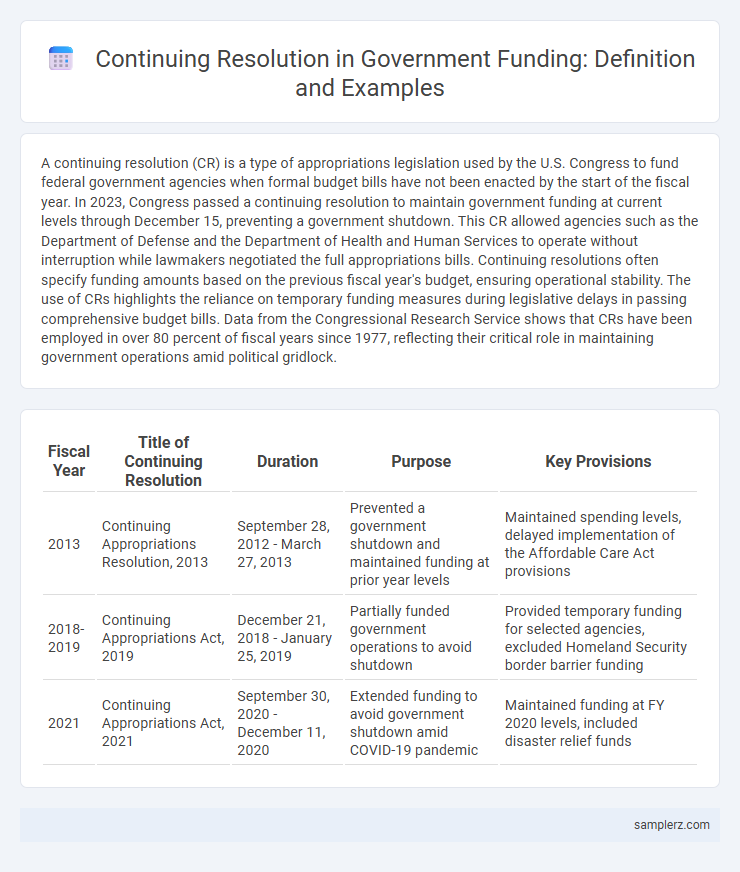A continuing resolution (CR) is a type of appropriations legislation used by the U.S. Congress to fund federal government agencies when formal budget bills have not been enacted by the start of the fiscal year. In 2023, Congress passed a continuing resolution to maintain government funding at current levels through December 15, preventing a government shutdown. This CR allowed agencies such as the Department of Defense and the Department of Health and Human Services to operate without interruption while lawmakers negotiated the full appropriations bills. Continuing resolutions often specify funding amounts based on the previous fiscal year's budget, ensuring operational stability. The use of CRs highlights the reliance on temporary funding measures during legislative delays in passing comprehensive budget bills. Data from the Congressional Research Service shows that CRs have been employed in over 80 percent of fiscal years since 1977, reflecting their critical role in maintaining government operations amid political gridlock.
Table of Comparison
| Fiscal Year | Title of Continuing Resolution | Duration | Purpose | Key Provisions |
|---|---|---|---|---|
| 2013 | Continuing Appropriations Resolution, 2013 | September 28, 2012 - March 27, 2013 | Prevented a government shutdown and maintained funding at prior year levels | Maintained spending levels, delayed implementation of the Affordable Care Act provisions |
| 2018-2019 | Continuing Appropriations Act, 2019 | December 21, 2018 - January 25, 2019 | Partially funded government operations to avoid shutdown | Provided temporary funding for selected agencies, excluded Homeland Security border barrier funding |
| 2021 | Continuing Appropriations Act, 2021 | September 30, 2020 - December 11, 2020 | Extended funding to avoid government shutdown amid COVID-19 pandemic | Maintained funding at FY 2020 levels, included disaster relief funds |
Definition and Purpose of Continuing Resolutions in Government Funding
Continuing resolutions (CRs) are temporary funding measures enacted by the U.S. Congress to maintain government operations when formal appropriations bills have not been approved by the start of the fiscal year. These resolutions prevent government shutdowns by providing budget authority based on previous appropriations levels, often extending funding for a specified period. The primary purpose of CRs is to ensure continuity of essential federal programs and services while lawmakers negotiate final appropriations.
Historical Overview of Continuing Resolutions in U.S. Congress
Continuing resolutions (CRs) have been a critical funding mechanism in the U.S. Congress since the mid-20th century, notably used to prevent government shutdowns when annual appropriations bills face delays. Historical examples include the extended CRs during the fiscal years 1996 and 2013, which maintained government operations amid budgetary impasses. These measures highlight Congress's reliance on CRs to sustain federal funding continuity while negotiating comprehensive budget agreements.
Notable Examples of Continuing Resolutions in Recent Years
The Continuing Appropriations Act, 2024, served as a critical funding measure after the federal government faced a potential shutdown in September 2023, extending funding at prior levels temporarily. The Consolidated Appropriations Act, 2023, included a continuing resolution that kept government operations funded through early 2023 amid budget negotiations. Another significant example is the Continuing Appropriations Act, 2022, which provided short-term funding extensions to avoid lapses during partisan budget impasses.
Key Provisions Commonly Found in Continuing Resolutions
Continuing resolutions (CRs) often maintain federal funding at prior year levels, preventing government shutdowns when regular appropriations bills are not enacted on time. Key provisions typically include prohibitions on new programs or expansions, restrictions on funding increases, and extensions of current project authorizations to sustain agency operations. These measures ensure the continuity of essential government functions while Congress finalizes annual budget agreements.
Impact of Continuing Resolutions on Federal Agencies
Continuing Resolutions (CRs) temporarily fund federal agencies at previous fiscal year levels, leading to operational uncertainties and delayed project implementations. During CR periods, agencies face challenges in initiating new programs or expanding existing services, often resulting in reduced employee morale and disrupted contract commitments. These funding delays hinder the efficiency and responsiveness of federal operations, affecting critical public services and long-term strategic planning.
Challenges and Criticisms of Relying on Continuing Resolutions
Continuing resolutions (CRs) often delay final budget approvals, causing uncertainty for federal agencies and hindering long-term project planning. Government programs face disruptions and inefficiencies due to the temporary and limited funding CRs provide, complicating resource allocation and contract management. Critics argue that reliance on CRs undermines fiscal discipline and reduces transparency in government spending.
Case Study: 2018 Federal Government Funding Through Continuing Resolutions
The 2018 federal government funding was maintained through multiple continuing resolutions that averted a prolonged shutdown amid budget disagreements. These temporary funding measures provided short-term appropriations to various federal agencies while negotiations continued on full fiscal year budgets. The use of continuing resolutions during this period underscored their role as critical tools in sustaining government operations during political impasses.
Differences Between Continuing Resolutions and Appropriations Bills
A continuing resolution (CR) temporarily funds federal government operations at existing levels when formal appropriations bills are not enacted by the fiscal year deadline. Unlike appropriations bills, which provide detailed, specific funding allocations for government agencies, CRs maintain prior funding levels without addressing new priorities or adjustments. This mechanism prevents government shutdowns but limits flexibility in budget planning and resource allocation.
Political Implications of Using Continuing Resolutions for Funding
Continuing resolutions (CRs) often serve as temporary funding measures when Congress cannot agree on a full budget, leading to political stalemate and uncertainty. These short-term extensions can delay government programs and create inefficiencies in federal agencies due to unpredictable funding levels. Political implications include heightened partisan tensions, leverage in budget negotiations, and challenges in long-term fiscal planning.
Future Outlook: Alternatives to Continuing Resolutions in Government Budgeting
Exploring alternatives to continuing resolutions (CRs) highlights proposed bipartisan budget frameworks that aim to prevent funding gaps by establishing multi-year spending agreements. Implementing automatic, targeted spending adjustments and adopting biennial budgeting are strategies designed to enhance fiscal stability and reduce reliance on short-term CRs. These approaches emphasize proactive planning and improved legislative efficiency to ensure consistent government operations without disruption.

example of continuing resolution in funding Infographic
 samplerz.com
samplerz.com